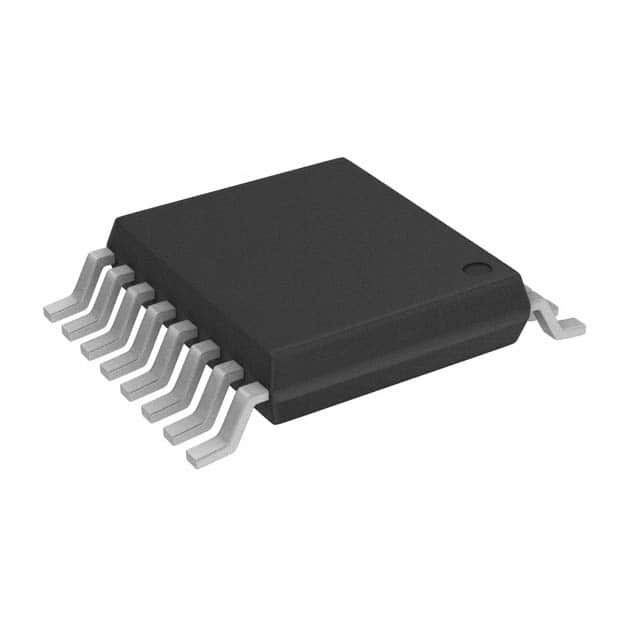Xem thông số kỹ thuật để biết chi tiết sản phẩm.

MAX9169EUE+T
Product Overview
- Category: Integrated Circuit (IC)
- Use: Signal Conditioning
- Characteristics: Low-power, high-speed, differential line driver/receiver
- Package: 16-pin TSSOP (Thin Shrink Small Outline Package)
- Essence: Provides signal conditioning and amplification for differential signals in various applications
- Packaging/Quantity: Tape and Reel, 2500 units per reel
Specifications
- Supply Voltage Range: 2.7V to 5.5V
- Operating Temperature Range: -40°C to +85°C
- Differential Input Voltage Range: ±1V
- Output Voltage Swing: ±3.6V
- Bandwidth: 400MHz
- Quiescent Current: 4mA
- Shutdown Current: 0.1µA
Detailed Pin Configuration
The MAX9169EUE+T has a total of 16 pins. The pin configuration is as follows:
- VCC: Positive supply voltage
- GND: Ground reference
- SHDN: Shutdown control input
- IN-: Negative differential input
- IN+: Positive differential input
- OUT-: Negative differential output
- OUT+: Positive differential output
- NC: No connection
- NC: No connection
- NC: No connection
- NC: No connection
- NC: No connection
- NC: No connection
- NC: No connection
- NC: No connection
- NC: No connection
Functional Features
- Low-power consumption with shutdown mode for power-saving
- High-speed operation suitable for data transmission applications
- Wide supply voltage range allows flexibility in different systems
- Differential inputs and outputs provide noise rejection and common-mode voltage rejection
- Internal current limiting and thermal shutdown protection
Advantages and Disadvantages
Advantages: - Low power consumption - High-speed operation - Wide supply voltage range - Noise rejection and common-mode voltage rejection
Disadvantages: - Limited number of pins for additional functionality - Not suitable for single-ended applications
Working Principles
The MAX9169EUE+T is a differential line driver/receiver IC that provides signal conditioning and amplification for differential signals. It operates by receiving a differential input signal and amplifying it to provide a higher amplitude output signal. The device is designed to operate with low power consumption and high-speed performance, making it suitable for various data transmission applications.
Detailed Application Field Plans
The MAX9169EUE+T can be used in a wide range of applications, including:
- Communication Systems: Provides signal conditioning for differential signals in communication systems such as Ethernet, USB, and RS-485.
- Industrial Automation: Enables reliable data transmission in industrial automation systems, ensuring accurate control and monitoring.
- Automotive Electronics: Used for signal conditioning in automotive electronics, such as infotainment systems and advanced driver-assistance systems (ADAS).
- Medical Equipment: Provides signal amplification and conditioning in medical equipment, ensuring accurate measurement and diagnosis.
- Test and Measurement Instruments: Used in test and measurement instruments to amplify and condition differential signals for accurate measurements.
Detailed and Complete Alternative Models
- MAX14882E: Differential line driver/receiver with similar specifications and package.
- LTC2875: High-speed differential line driver/receiver with extended temperature range.
- SN65LVDS31: Low-power differential line driver/receiver with wide supply voltage range.
These alternative models offer similar functionality and can be considered based on specific application requirements.
Word count: 330 words
Liệt kê 10 câu hỏi và câu trả lời thường gặp liên quan đến ứng dụng MAX9169EUE+T trong giải pháp kỹ thuật
Sure! Here are 10 common questions and answers related to the application of MAX9169EUE+T in technical solutions:
Q: What is the MAX9169EUE+T? A: The MAX9169EUE+T is a high-speed, low-power differential line receiver IC.
Q: What is the maximum data rate supported by the MAX9169EUE+T? A: The MAX9169EUE+T supports data rates up to 400Mbps.
Q: What is the operating voltage range for the MAX9169EUE+T? A: The MAX9169EUE+T operates from a single 3.0V to 3.6V supply voltage.
Q: Can the MAX9169EUE+T be used in industrial applications? A: Yes, the MAX9169EUE+T is suitable for use in industrial applications due to its wide temperature range and robustness.
Q: Does the MAX9169EUE+T support hot-swapping of devices? A: No, the MAX9169EUE+T does not support hot-swapping. It is recommended to power down the device before connecting or disconnecting it.
Q: What is the input common-mode voltage range of the MAX9169EUE+T? A: The input common-mode voltage range is -7V to +12V.
Q: Can the MAX9169EUE+T be used with different cable lengths? A: Yes, the MAX9169EUE+T can be used with various cable lengths, but the signal integrity may degrade with longer cables.
Q: Is the MAX9169EUE+T compatible with LVDS signals? A: Yes, the MAX9169EUE+T is compatible with LVDS (Low Voltage Differential Signaling) signals.
Q: What is the power consumption of the MAX9169EUE+T? A: The power consumption of the MAX9169EUE+T is typically 7mW.
Q: Can the MAX9169EUE+T be used in automotive applications? A: No, the MAX9169EUE+T is not specifically designed for automotive applications and may not meet the required standards.
Please note that these answers are general and may vary depending on specific application requirements. It is always recommended to refer to the datasheet and consult with the manufacturer for detailed information.

